Guiding principles of Presbyterian mission
Presbyterians Today
Ministry candidates talk about them. Moderators share them with session members during meetings. Pastors do sermon series on them. “They” are the Great Ends of the Church — statements crafted in the early 20th century to guide the vision and mission of the Presbyterian Church. But who can recite all six Great Ends? (Be honest.) And what do these Great Ends look like when lived out? Presbyterians Today explores how congregations embrace these guiding principles in ways that show their communities the power of love in action.
The proclamation of the gospel for the salvation of humankind
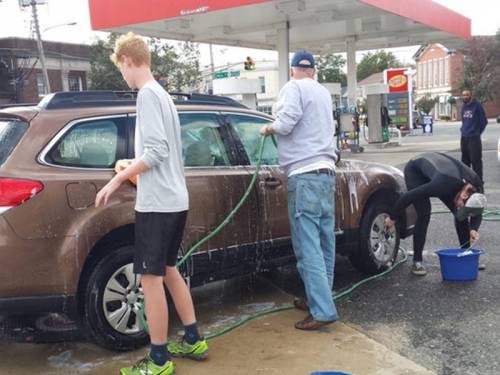 “Don’t go to church. Be the church!” is the motto of the “Church Has Left the Building” movement that has spread like Holy Spirit fire to Woodstown Presbyterian Church in Woodstown, New Jersey. Every October, the church closes its doors on one Sunday and sends small groups of all ages into the community to proclaim the gospel through hands-on work.
“Don’t go to church. Be the church!” is the motto of the “Church Has Left the Building” movement that has spread like Holy Spirit fire to Woodstown Presbyterian Church in Woodstown, New Jersey. Every October, the church closes its doors on one Sunday and sends small groups of all ages into the community to proclaim the gospel through hands-on work.
“We have to rethink what church is. Worship isn’t only what we do on a Sunday,” said the Rev. Eryn Mera, the church’s pastor. In the past, teams have been sent out to do community beautification projects like painting lampposts and picking up trash, acts of compassion such as tying comfort blankets for Hearts United Against Cancer, serving at a food pantry or soup kitchen, visiting the elderly at a local health care center and working with Habitat for Humanity. This fall, Woodstown Presbyterian is focusing on ways to feed the poor.
“The ‘Church Has Left the Building’ movement has impacted both our church and the community with this kind of relational evangelism,” Mera said. “Jesus told us to be salt and light in the world, not in a church building. Through these projects we discover how Jesus wants to launch his people to live on the outside what we believe on the inside.”
The Presbyterian volunteers participate with five other churches from multiple denominations. At the end of the service day the teams gather for community worship as one united church, praising God for what God has done and sharing the stories of the day.
Tip: When holding a “Church Has Left the Building” Sunday, make time to educate the congregation prior to the event. There might be some who don’t see the value of giving up a Sunday sitting in the pew or others who have logistical questions.
The shelter, nurture and spiritual fellowship of the children of God
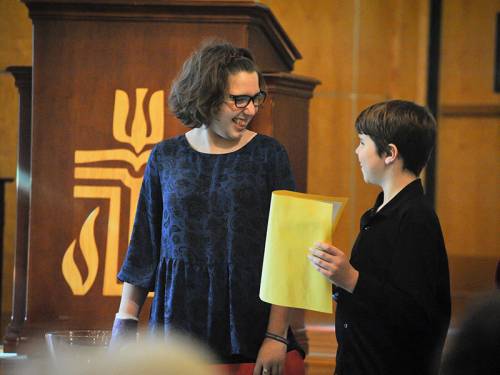 On the second Sunday of every month, the congregation of Eastridge Presbyterian Church in Lincoln, Nebraska, gathers at 9 a.m. to participate in GiFT (Growing in Faith Together). GiFT features a learning activity, followed by a time of fellowship and then a shared meal. According to a brochure publicizing the program, the morning “reclaims God’s intent for faith to be shared in community and across generations.”
On the second Sunday of every month, the congregation of Eastridge Presbyterian Church in Lincoln, Nebraska, gathers at 9 a.m. to participate in GiFT (Growing in Faith Together). GiFT features a learning activity, followed by a time of fellowship and then a shared meal. According to a brochure publicizing the program, the morning “reclaims God’s intent for faith to be shared in community and across generations.”
The Rev. Thomas Dummermuth, the associate pastor at Eastridge, helped start the intergenerational program in 2016. The idea grew
out of several continuing education experiences with Vibrant Faith (vibrantfaith.org).
“What has been practiced in small churches for a long time had fallen aside in many midsize and larger churches, where faith formation often happens solely in ‘age-appropriate’ groups,” said Dummermuth.
Each season of GiFT focuses on different themes. The 2016–17 season was titled “Justice and Service,” addressing themes such as home and shelter and “love thy neighbor.” The 2017–18 season was about “Life-Giving Rhythms,” and focused on how and why the church celebrates holidays and seasons such as Pentecost, All Saints’ Day, Advent and Holy Week. Next season, GiFT will center on creeds and confessions, Dummermuth says.
“What I love about it,” he added, “is that it has us learning together. It gives us a main thread that we follow throughout the year with different activities.”
Tip: Create ways for young and old to learn together by holding a special Sunday educational event such as Eastridge’s GiFT program. Or perhaps create mentoring opportunities by teaming older members of the congregation with children. Hold special mentoring activities such as sharing stories over ice cream. Encourage young and old to pray for each other and even write letters to one another. Yes, write — not email.
The maintenance of divine worship
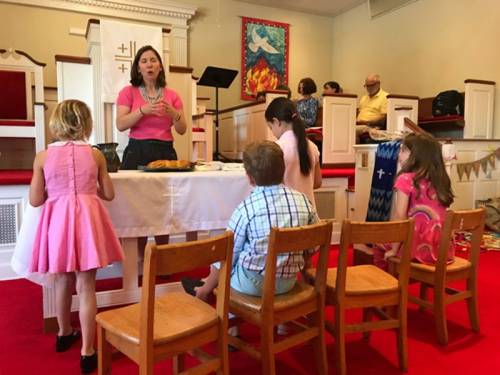 Shortly after the Rev. Karen Ware Jackson came to Faith Presbyterian Church in Greensboro, North Carolina, eight of the church’s elderly members passed away. Two pews had to be removed to make space for a casket; the pews were never reinstalled. Instead, Jackson saw an opportunity.
Shortly after the Rev. Karen Ware Jackson came to Faith Presbyterian Church in Greensboro, North Carolina, eight of the church’s elderly members passed away. Two pews had to be removed to make space for a casket; the pews were never reinstalled. Instead, Jackson saw an opportunity.
“The Holy Spirit was moving and creating space for a ‘prayground’ for young children,” she said. Re-creating the open space with a table in front of the pulpit became a way to embrace cross-generational worship.
Through Jackson’s blogs, one-on-one conversations and sermons that focused on “worship with all ages,” the church got the message.
“The little church made space for God to bring new life out of death,” Jackson said.
While she preaches, the children are gathered around the table, guided through the service with prayers and activities. As the Scriptures are being interpreted, the children interpret what they hear with Play-Doh, drawings, Legos, feathers or glitter.
“What we do isn’t just for the kids; it’s for us all,” Jackson said. “The prayground is making us whole. We are the body of Christ. Kids are a loud and messy part of the body, but when we pull the kids out of worship, it’s like we are dismembering the body, like trying to worship blindfolded. Kids are distracting, yes, but they bring us life and they bring us joy, and they bring surprising depth and mirth. They understand the holy power of prayer and praise. They are hungry for God.”
Tip: If a prayground is too much, too soon for your congregation, ask session members, worship leaders and/or educational leaders how children can be creatively integrated into worship. Begin the conversation this fall and see where it leads.
The preservation of the truth
 Megan and Dave Collins host a podcast called “Everything Jesus Taught” about exactly that — what Jesus taught about God, life, forgiveness, money, family and the way his teachings are to inform the way we live out our faith in the 21st century.
Megan and Dave Collins host a podcast called “Everything Jesus Taught” about exactly that — what Jesus taught about God, life, forgiveness, money, family and the way his teachings are to inform the way we live out our faith in the 21st century.
As co-pastors of Maitland Presbyterian Church in Orlando, Florida, they take the pulpit to the public by way of the podcast. Through their conversational approach, they work together to discern what is truth and how to find it. Often using real-life humor, the two discuss and sometimes disagree about how to understand a particular teaching.
“Truth isn’t something we receive,” said Dave Collins. “We have to interact with it, talk about it, digest it, parse out how it works in our lives, not just give it intellectual ascent. That’s how truth bears fruit in our lives.”
Discerning between what is cultural in the Scriptures and what is theological is one of the most difficult tasks for the church today. As these two pastors reason, together, they invite the wider world into a deeper dialogue with others and within oneself.
“The podcast is unedited. We wrestle out loud as we work to fully comprehend what Jesus taught. Truth is what he taught, but how can we translate that in the world we live in and the lives we live is the challenge,” said Megan Collins. “We start with the Gospels and Scripture and we live into the theology — we make theology live.”
Tip: You don’t need a podcast to get conversations going. Hold a sermon “talk back” on Sundays, inviting people to delve more deeply into the Scripture lesson and to share what they heard, agreed with or disagreed with.
The promotion of social righteousness
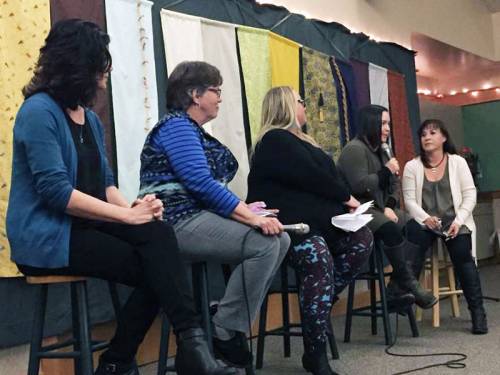 In 2012, as the Church in the Tetons in Driggs, Idaho, was opening its doors, Monica Carrillo was approved to stay in the U.S. through Deferred Action for Childhood Arrivals (DACA). She received a renewable two-year period of deferred action from deportation and got a work permit and a driver’s license. She joined the local Family Safety Network, where she met the director of client services and outreach, Emily Bilcher — who is also the wife of the Church in the Tetons’ pastor. Through her friendship with Emily Bilcher at work, and then the Rev. Karlin Bilcher, her life opened. And, through Carrillo, the Bilchers gained insight into the lives of undocumented immigrants. They began showing up at community meetings on immigration issues.
In 2012, as the Church in the Tetons in Driggs, Idaho, was opening its doors, Monica Carrillo was approved to stay in the U.S. through Deferred Action for Childhood Arrivals (DACA). She received a renewable two-year period of deferred action from deportation and got a work permit and a driver’s license. She joined the local Family Safety Network, where she met the director of client services and outreach, Emily Bilcher — who is also the wife of the Church in the Tetons’ pastor. Through her friendship with Emily Bilcher at work, and then the Rev. Karlin Bilcher, her life opened. And, through Carrillo, the Bilchers gained insight into the lives of undocumented immigrants. They began showing up at community meetings on immigration issues.
When the local Hispanic Resource Center brought in a lawyer from Salt Lake City to help immigrants fill out paperwork right after the 2016 presidential election, the Bilchers noticed that other people from the church were there.
They recruited a few members to help start a new ministry at the church. Based on hospitality and welcoming strangers, the ministry was called “radical neighboring,” and the Bilchers invited Carrillo to the church to tell her story publicly. Hearing Carrillo’s story, the congregation held a community forum on immigration to help the town understand the stress and struggles that undocumented immigrants face while living in this country. The congregation also began to develop a relationship with the primarily Hispanic Good Shepherd Catholic Church.
Karlin Bilcher acknowledges that not everyone at the church, or in the community, is on board with the radical neighboring ministry they have started. But he’s OK with that, because the Church in the Tetons, and the town, is made up of a diverse group of people who don’t always think the same way.
Recently, a young couple called Bilcher because they’d heard about this radical neighboring ministry. They’d never been to church, but they wanted to know what it might mean for them for them to come — and what might be required of them.
“They had absolutely no idea,” Bilcher said. “But in a way, they reflect both our community and church, in that we don’t know much about the lives of people who are different than us.”
Tip: Invite members of your session, outreach team, membership committee or deacons to take a walk around your neighborhood, noticing the needs and those whom the church is not currently reaching. Then begin talking about what “radical neighboring” would look like in your community.
The exhibition of the kingdom of heaven to the world
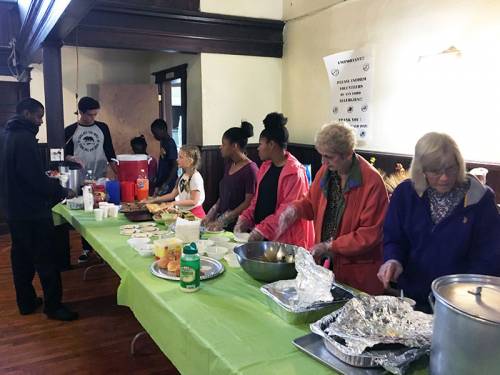 What happens when two women from one Presbyterian church share their concerns for the working poor with another Presbyterian church? A new reformation happens. Nearly 13 years ago on Reformation Sunday, two women from Memorial West United Presbyterian Church in Newark, New Jersey, went to their neighboring church, Livingston Presbyterian, to talk about what could be done for those suffering in their community. The conversation quickly led to the creation of the Seventh Street Bistro — a ministry offering a free, hot meal every Saturday.
What happens when two women from one Presbyterian church share their concerns for the working poor with another Presbyterian church? A new reformation happens. Nearly 13 years ago on Reformation Sunday, two women from Memorial West United Presbyterian Church in Newark, New Jersey, went to their neighboring church, Livingston Presbyterian, to talk about what could be done for those suffering in their community. The conversation quickly led to the creation of the Seventh Street Bistro — a ministry offering a free, hot meal every Saturday.
Today the ministry is a partnership with not just Memorial West and Livingston Presbyterian, but First Presbyterian and Trinity Church and Living Stone Christian Church as well. Approximately 50–60 people show up for a nutritious, home-cooked meal. The Bistro isn’t your average soup kitchen, though. The Bistro is also a place where people can receive clothes weekly and hygiene packs monthly.
The Bistro has celebrations throughout the year: a cookout in July, a back-to-school drive in August, a coat drive in the winter and a Christmas dinner served on Christmas Day. In conjunction with the traditional Christmas dinner, small gifts are given. In November members plan to offer their first free health fair.
Josephine Jackson, a member of Memorial West who has been involved since the beginning of the ministry, says the Bistro is more than just food — it builds relationships in the community. And Memorial West? The church has become a shared space where community members feel some ownership and responsibility. In fact, one Saturday, she says, a guest was smoking outside the church and another guest said, “Don’t smoke here — this is holy ground.”
The volunteers are dedicated and always seeking how to help others. Sylvester Brown, head of the Bistro board, says they are always asking how they can assist in bettering someone’s life. They offer prayer and support for the community, exhibiting the realm of God in a hurting world.
Tip: There is strength in numbers. Don’t go it alone. Begin working with other churches on ways to serve the community — together.
Sherry Blackman, Rebecca Lister, Katrina Pekich-Bundy, Donna Frischknecht Jackson and Paul Seebeck contributed to this story.
The Great Ends of the Church
- The proclamation of the gospel for the salvation of humankind
- The shelter, nurture and spiritual fellowship of the children of God
- The maintenance of divine worship
- The preservation of the truth
- The promotion of social righteousness
- The exhibition of the kingdom of heaven to the world
— Book of Order (2017–19), F-1.0304
Becoming a vital congregation
A new initiative helping congregations live big in terms of mission and ministry is being piloted in the Presbyterian Church (U.S.A.). The Vital Congregations Revitalization was recently introduced to Newark and Trinity presbyteries, says Kathryn Threadgill, associate for vital congregations in the Presbyterian Mission Agency. Threadgill, who worked with Theology, Formation & Evangelism ministries’ acting director, Ray Jones, on Vital Congregations for more 10 months, says the initiative builds on the six Great Ends of the Church, identifying seven key characteristics of a vital congregation. Those characteristics are: caring relationships; lifelong discipleship; intentional evangelism; outward incarnational focus (on God coming to be with us in Jesus Christ); empowered servant leadership; Spirit-inspired worship; and ecclesial health.
Congregations in the pilot presbyteries will work for two years on revitalization, spending their first year focusing on authentic relationships and assessing where they are as a congregation in relation to the seven marks of vital congregations. In the second year, congregations will determine a course of direction involving one of these three options:
• Re-forming churches — Re-envisioning and changing how to be the church together through the seven marks of congregational vitality.
• Missional clustering churches — Revitalizing by clustering congregations into new communities of worship and ministry.
• Death and resurrection churches — Revitalizing through the death and legacy of a congregation, in witness to the resurrection.
To date, 13 churches have signed up for the revitalization initiative in Newark Presbytery. An additional 12 pastors signed up to join pastors of those 13 churches in cohort work, in hopes of eventually bringing their congregations into the revitalization process. Another 14 churches have signed up for the initiative in Trinity Presbytery.
The presbyteries of San Jose, Grand Canyon and de Cristo are also embarking on the revitalization initiative, bringing the total of congregations involved to 40.
A Vital Congregations Toolkit is available for congregations who want to begin the revitalization conversation. Go to pcusa.org/vitalcongregations
![]() You may freely reuse and distribute this article in its entirety for non-commercial purposes in any medium. Please include author attribution, photography credits, and a link to the original article. This work is licensed under a Creative Commons Attribution-NonCommercial-NoDeratives 4.0 International License.
You may freely reuse and distribute this article in its entirety for non-commercial purposes in any medium. Please include author attribution, photography credits, and a link to the original article. This work is licensed under a Creative Commons Attribution-NonCommercial-NoDeratives 4.0 International License.
Categories: Presbyterians Today
Tags: gospel, great ends of the church, kingdom of heaven, salvation, social righteousness, spirituality, truth, Vital Congregations, worship
Ministries: Presbyterians Today, Theology and Worship, Vital Congregations